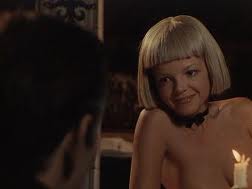So that was Kenneth Tynan, the theatre critic – an enthusiastic man with the back of a hairbrush, but mostly only cruel in his reviews – who campaigned for the end of Britain’s bizarre theatre censorship, and celebrated his victory by putting on Oh! Calcutta! Originally, Oh! Calcutta! included bdsm sequences he wrote himself. These have been quietly dropped from the current revival.
By the way, Tynan’s Diaries were published a few years ago. I read them after they were remaindered. Whoever thought they were worth printing didn’t do the man’s reputation any favours. On a day-by-day basis Tynan comes across as silly, self-satisfied and a bit boring. He must have been more interesting in person than he was on the page, or they wouldn’t have put him on television so he could say ‘fuck’ to everyone.
Anyway, before Tynan’s fine work getting the Lord Chamberlain out of the British theatrical censorship business, there used to be some extraordinary performances in the clubs that catered for gentlemen who wanted to see naked ladies on the stage while they enjoyed a quiet drink in semi-darkness with a raincoat across their lap. Theatrical censorship created a new theatrical art form: the erotic tableau vivant.

That’s lovely, darlings. That’s Art, that is. Now, don’t move!
In erotic tableaux vivants, naked women and the occasional naked man would enact erotic scenes from classical myth or literature: The Rape of the Sabine Women, or The Birth of Venus, for example, or Hot Nymphs Bathing by a Sylvan Pool. Or they could present “historical” scenes, like Brutal Cossacks Whipping a Naked Female Anarchist. You could have nudity, simulated sex, rape, flagellation and other stirring scenes on the stage, so long as the “actors” kept perfectly silent and never moved a muscle.
This happened because a theatre manager – Mr Crommer, of The Windmill Theatre in London’s Soho district, pointed out to the Lord Chamberlain that he couldn’t logically say that he thought nudity itself was indecent. If he thought that, he’d have to ban nude statues and paintings.

A still from the film “Frank and I”, also released as “Lady Libertine”. The film includes a scene in which the hero, Charles, visits a brothel and is shown “tableaux vivants”.
Therefore the Lord Chamberlain couldn’t consistently claim that nude actors on stage was indecent: it must only be indecent if the actors did what actors usually do: walk around, talk, do stage “business”. So British stages were allowed to present nudity, so long as the naked girls were perfectly silent and still, as if they were statues, or the human figures in a painting.
The rule was that if the performers moved or talked, the performance was obscene, but if they kept still, it was artistic.
We are working our way back, I promise, to the night of Sa’afia’s punishment.
